Coins of the Indian rupee
Coins of the Indian rupee were first minted in 1950. New coins have been produced annually since then and they make up a valuable aspect of the Indian currency system. Today, circulating coins exist in denominations of ₹1, ₹2, ₹5, and ₹10. All of these are produced by four mints located across India, in Kolkata, Mumbai, Hyderabad and Noida.
History
After Indian independence, British Indian coins were in use as a frozen currency until India became a republic in 1950. The first rupee coins of the Republic of India were minted in 1950. These included 1/2 rupee, 1/4 rupee, 2 anna, 1 anna, 1/2 anna & 1 pice coins, and are referred to as the anna series or pre-decimal coinage. Under the anna series, one rupee was divided into 16 annas or 64 pice, with each anna equal to 4 pice.
In 1957, India shifted to the decimal system, though for a short period of time, both decimal and non-decimal coins were in circulation. To distinguish between the two pice coins in circulation, the coins minted between 1957 and 1964 were printed with the legend “Naya Paisa” (“New Paisa”). The denominations in circulation were 1, 2, 3, 5, 10, 20, 25, 50 (naya) paisa and one rupee. Since rupees retained their pre-decimal value, pre-decimal coins of one, half and quarter rupees remained in circulation after decimalisation.
The word "naya" was dropped in 1964 and a new denomination, the 3 paisa, was introduced into circulation. A 20 paisa coin was minted in 1968. Neither of these coins gained much popularity. The 1, 2 and 3 paisa coins were phased out gradually in the 1970s. In 1982, a new 2 rupee coin was introduced experimentally to replace 2 rupee notes. The 2 rupee coin was not minted again till 1990, after which it was minted every following year.
Stainless steel coinage of 10, 25 and 50 paisa was introduced in 1988. In 1992, a new stainless steel rupee coin, smaller and lighter than the older rupee, was minted, alongside a 5 rupee Cupronickel coin.
In 2005, the 10 rupee coin was minted for the first time. Higher denomination coins were introduced due to an increasing demand for change and the increasing cost of printing 2, 5 and 10 rupee banknotes.
On 30 June 2011, all coins in denominations of 25 paisa and below were officially demonetised. Commemorative coins in circulation can be found in various denominations. They depict various special events or people, including Mahatma Gandhi, Jawaharlal Nehru, Indira Gandhi, B. R. Ambedkar, Rajiv Gandhi, Dnyaneshwar, the 1982 Asian Games, Sardar Vallabhbhai Patel, Subhas Chandra Bose, Sri Aurobindo, Chittaranjan Das, Chhatrapati Shivaji, the 2010 Commonwealth Games, Bhagat Singh and Rabindranath Tagore.
Coin series: 1947-1950 (pre-decimalization)
Union of India 1947–1950
At Independence on 15 August 1947, India was partitioned into the new British Dominions of India and Pakistan. The new Dominion (or Union) of India retained the previous imperial currency with images of British monarchs. The basic unit of currency was the Indian rupee, which was itself divided into annas (16 annas to a rupee) and pice (the old spelling of paisa - 64 pice to a rupee).[1] The lowest-denomination Indian coins, the half-pice (128 to a rupee) and the pie (192 to a rupee) were officially demonetized in 1947; while both denominations had continued to circulate up to that time, new examples were not minted after 1942 as they were practically worthless (India remained a member of the sterling area after independence and the rupee remained pegged to the pound sterling. Until 1966, the rupee was worth 1s.6d, or 18 old British pence; a half-pice was therefore worth 0.141 old pence and a pie 0.09 old pence.)[2]
From 15 August 1947 until 26 January 1950, the Indian coinage structure was as follows: (bold - denominations minted)[3]
| Rupee and its fractions | Annas | Pice | Pies (demonetized after 1947) |
|---|---|---|---|
| Rupee | 16 annas | 64 pice | 192 pies |
| Half rupee | 8 annas | 32 pice | 96 pies |
| Quarter rupee | 4 annas | 16 pice | 48 pies |
| 1/8 rupee | 2 annas | 8 pice | 24 pies |
| 1/16 rupee | 1 anna | 4 pice | 12 pies |
| 1/32 rupee | Half anna | 2 pice | 6 pies |
| 1/64 rupee | 1/4 anna | 1 pice | 3 pies |
This represented the currency arrangements during the transition period up to the establishment of the Indian Republic.
The coins used after 1947 until the introduction of Republic of India - Pre decimalisation series were as follows:
| Denomination | Image | Metal | Shape | Diameter | Minted in Year | |
|---|---|---|---|---|---|---|
| Obverse | Reverse | |||||
| One Rupee |  |
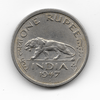 |
Nickel | Circular | 28 mm | 1947 |
| Half Rupee | 24 mm | 1946 - 1947 | ||||
| Quarter Rupee | 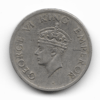 |
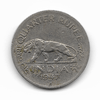 |
19 mm | 1946 - 1947 | ||
| 2 Annas | Nickel - Brass | Square | 25.1 mm | 1945 | ||
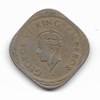 |
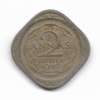 |
Copper - Nickel | 22 mm | 1946 - 1947 | ||
| 1 Anna | Nickel - Brass | 12 Scalloped | 21 mm | 1945 | ||
| Copper - Nickel | 21 mm | 1946 - 1947 | ||||
| 1/2 Anna |  |
 |
Square | 19.7 mm | 1946 - 1947 | |
| 1 Pice |  |
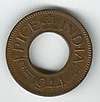 |
Bronze | Circular with a hole | 21.32 mm | 1943 - 1947 |
Republic of India 1950-1957
On 26 January 1950, India became a sovereign republic. This series was introduced on 15 August 1950 and represented the first coinage of Republic India. The British King's portrait was replaced by the Lion Capital of the Ashoka Pillar. A corn sheaf replaced the Tiger on the one rupee coin. In some ways this symbolised a shift in focus to progress and prosperity. Indian motifs were incorporated on other coins. The previous monetary system and the old units of currency were retained unchanged.
| Denomination | Image | Metal | Shape | Diameter | Minted in Year | |
|---|---|---|---|---|---|---|
| Obverse | Reverse | |||||
| One Rupee | Nickel | Circular | 27.9 mm | 1950 - 1954 | ||
| Half Rupee | 24 mm | 1950 - 1956 | ||||
| Quarter Rupee |  |
 |
19 mm | 1950 - 1956 | ||
| Two Annas | Cupro-Nickel | Square | 25.4 mm | 1950 - 1955 | ||
| One Anna | 12 Scalloped | 21 mm | 1950 - 1955 | |||
| Half Anna |  |
 |
Square | 19.5 mm | 1950 - 1955 | |
| One Pice | Bronze | Circular | 21 mm | 1950 - 1955 | ||
Decimalization
The move towards decimalization was afoot for over a century. However, it was in September, 1955 that the Indian Coinage Act was amended for the country to adopt a metric system for coinage. The Act came into force with effect from 1 April 1957, after which anna and pice denominations were demonetised. The rupee remained unchanged in value and nomenclature. It, however, was now divided into 100 'paisa' instead of 16 annas or 64 pice. Effective from 30 June 2011, all coins in denominations of 25 paisa and below were officially demonetized.[4]
| Pre-decimal currency (1950-1957; minting ceased in 1955) | Decimal currency replacement (1957–present) | Decimal currency (dates minted) |
|---|---|---|
| N/A | 10 rupees | 2006–present |
| N/A | 5 rupees | 1992–present |
| N/A | 2 rupees | 1982–present |
| Rupee | Rupee (divided into 100 new paisa 1957-1964; divided into 100 paisa 1964–present. | 1962–present |
| Half rupee | 50 paisa | 1960–present |
| Quarter rupee | 25 paisa | 1957-2002. Demonetized from 2011. |
| N/A | 20 paisa | 1968-1994. Demonetized from 2011. |
| 2 annas | 10 paisa | 1957-1998. Demonetized from 2011. |
| Anna | 5 paisa | 1957-1994. Demonetized from 2011. |
| N/A | 3 paisa | 1964-1972; proofs minted until 1981. Demonetized from 2011. |
| Half anna | 2 paisa | 1957-1979; proofs minted until 1981. Demonetized from 2011. |
| Pice | Paisa | 1957-1972; proofs minted until 1981. Demonetized from 2011, but retained as a unit of currency. |
Coin series 1957-present (decimal)
Naya paisa series 1957–1963
The antiquated spelling of "pice" was modified to "paisa" in the singular and "paise" in the plural. For public recognition, the new decimal paisa was termed 'Naya Paisa' (New Paisa) till 1 June 1964 when the term 'Naya' was dropped. The coins of 50p, 25p, 10p, 5p, 2p, and 1p had a legend in Devanagari script explaining the value of coin in terms of fraction of a rupee.
| Denomination | Image | Metal | Shape | Diameter | Minted in Year | |
|---|---|---|---|---|---|---|
| Obverse | Reverse | |||||
| One Rupee | Nickel | Circular | 28 mm | 1962 - 1974 | ||
| Fifty Naye paisa | 24 mm | 1957 - 1963 | ||||
| Twenty Five Naye paisa | 19 mm | 1957 - 1963 | ||||
| Ten Naye paisa | 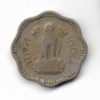 |  |
Eight Scalloped | Cupro-Nickel | 23 mm (across scallops) | 1957 - 1963 |
| Five Naye paisa | 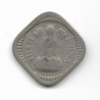 | 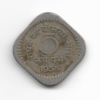 |
Square | 22 mm (across corners) | 1957 - 1963 | |
| Two Naye paise | 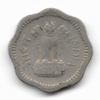 |
 |
Eight Scalloped | 18 mm (across scallops) | 1957 - 1963 | |
| One Naya Paisa | .jpg) | .jpg) |
Bronze | Circular | 16 mm | 1957 - 1962 |
| Nickel Brass | 1962 - 1963 | |||||
Paisa series I with Devanagari Legend 1964 onwards
In June 1964, the term 'Naya' was dropped and the coins were reminted. The legend in Devanagari script explaining the value of coin in terms of fraction of a Rupee continued till it was finally dropped from the new design minted 1964 onwards.
| Denomination | Image | Metal | Shape | Diameter | Minted in Year | |
|---|---|---|---|---|---|---|
| Obverse | Reverse | |||||
| 50 paisa | Nickel | Circular | 24 mm | 1964 - 1971 | ||
| 25 paisa | Nickel | 19 mm | 1964 - 1972 | |||
| 10 paisa | 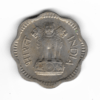 |
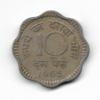 |
Copper Nickel | 8 Scalloped | 23 mm | 1964 - 1967 |
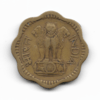 |
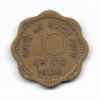 |
Nickel Brass | 1968 - 1971 | |||
| 5 paisa |  |
 |
Copper Nickel | Square | 22 mm | 1964 - 1966 |
| Aluminium | 1967 - 1971 | |||||
| 2 paisa | 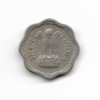 |
 |
Copper Nickel | 8 Scalloped | 18 mm | 1964 |
| 1 paisa | Nickel Brass | Circular | 16 mm | 1964 | ||
Series II without the Devanagari Legend (1964 - 1983)
The coin minted from 1965 did not have the legend in Devanagari, explaining the value of the coin as a fraction of the rupee. Small denomination coins which were made of bronze, nickel-brass, cupro-nickel, and aluminium-bronze were gradually minted in aluminium.The first coin minted in such type was the 3 Paisa coin in 1964, which was a new denomination, and continued to be minted till 1971. One and Two paisa coins were changed to Aluminium and were minted without the Devanagari legend from 1965. 20 paisa coin was introduced in 1968, which continued to be minted till 1971.
| Denomination | Image | Metal | Shape | Diameter | Minted in Year | |
|---|---|---|---|---|---|---|
| Obverse | Reverse | |||||
| 1 rupee | Copper Nickel | Circular | 28 mm | 1975 - 1982 | ||
| 50 paisa | 24 mm | 1972 - 1973 | ||||
| 1974 - 1983 | ||||||
| 25 paisa | 19 mm | 1972 - 1990 | ||||
| 20 paisa | 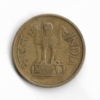 |
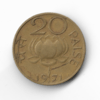 |
Nickel Brass | 22 mm | 1968 - 1971 | |
| 10 paisa | Aluminium | 12 Scalloped | 25.91 mm | 1971 - 1982 | ||
| 5 paisa |  |
 |
Square | 22 mm | 1972 - 1984 | |
| 3 paisa | 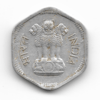 |
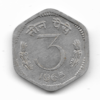 |
Hexagonal | 21 mm | 1964 - 1971 | |
| 2 paisa |  |
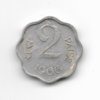 |
8 Scalloped | 20 mm | 1965 - 1981 | |
| 1 paisa | Square | 17 mm | 1965 - 1981 | |||
Series III 1982 Onwards
From 1982, New series was launched. the 20 paisa coin which was last minted in 1971, was reintroduced again, but in Aluminium. The size and the design of 10 paisa, 50 paisa and 1 rupee was changed, though they continued to be minted in the same metal. Coins of 3p, 2p and 1p were discontinued but continued to be the legal tender.
| Denomination | Image | Metal | Shape | Diameter | Minted in Year | |
|---|---|---|---|---|---|---|
| Obverse | Reverse | |||||
| 1 Rupee | Copper - Nickel | Circular | 26 mm | 1983 - 1991 | ||
| 50 paisa | 24 mm | 1984 - 1990 | ||||
| 20 paisa | 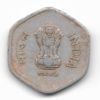 |
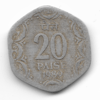 |
Aluminium | Hexagonal | 26 mm | 1982 - 1997 |
| 10 paisa | 8 Scalloped | 23 mm | 1983 - 1993 | |||
| 5 paisa | Square | 22 mm | 1984 - 1994 | |||
Series IV 1988 Onwards
In Series IV, 5 paisa and 20 paisa coins were discontinued though they continued to be minted in Series III till 1994 and 1997 respectively. 10 paisa, 25 paisa and 50 paisa coins were minted in Stainless Steel. 1992 onwards, 1 Re coin was also minted in Steel and Rs. 2 and Rs. 5 coins in Copper Nickel were introduced. The very considerable costs of managing note issues of Re 1, Rs 2, and Rs 5 led to the gradual coinage of these denominations. These coins continued to be minted till 2004, when the Unity in diversity series was launched.
Cupro-Nickel coins are not minted anymore. Ferritic Stainless Steel coins of Two and Five Rupee denominations are currently in production.[5]
2004 Unity in diversity Series
In 2004, RBI issued a series in denominations of 1 rupee, followed by 2 rupee and 10 rupee in 2005. These issues however came into circulation in 2006, and created a controversy over their design. 10 rupee coins were the first bimetallic coins issued in India, and because of the controversy and being minted in only one mint, most of the coinage never found its way into circulation. The ones which did were hoarded by Coin collectors and Coin hoarders.
| Denomination | Image | Metal | Shape | Diameter | Minted in Year | |
|---|---|---|---|---|---|---|
| Obverse | Reverse | |||||
| 10 rupee | Bimetallic
Copper Nickel Center in Aluminium Bronze ring |
Circular | 27 mm | 2005 - 2007 | ||
| 2 rupee | Stainless Steel | 26.75 mm | ||||
| 1 rupee | 25 mm | 2004 - 2006 | ||||
2007 Hasta Mudra Series
in 2007 RBI issued a new series of Coins, The Hasta Mudra Series, in coins of 50 paisa, 1 rupee and 2 rupee denominations. These coins are stainless steel and feature various Hasta Mudras (hand gestures in Indian Classical dance). The 5 rupee piece that features waves in its design was also issued in 2007, along with a new 10 rupee coin. However, the design of the 10 rupee piece changed in 2008. The 5 rupee coin design was again reverted to the previous design, though it was issued in Nickel-brass instead of Copper-nickel. However, these 5 rupee and 10 rupee coins were not the part of the Hasta Mudra series.
| Denomination | Image | Metal | Shape | Diameter | Minted in Year | |
|---|---|---|---|---|---|---|
| Obverse | Reverse | |||||
| 2 rupee | Stainless Steel | Circular | 27 mm | 2007 - 2011 | ||
| 1 rupee | 25 mm | |||||
| 50 paisa | 22 mm | 2008 - 2010 | ||||
The 5 rupee and 10 rupee coins were issued for common circulation in 2007, 2008, 2009 with changed designs and continued to be minted until the introduction of the Rupee Symbol series in 2011.
| Denomination | Image | Metal | Shape | Diameter | Minted in Year | |
|---|---|---|---|---|---|---|
| Obverse | Reverse | |||||
| 5 rupee | Stainless Steel | Circular | 23 mm | 2007 - 2008 | ||
| 10 rupee | Bimetallic
Copper Nickel Center in Aluminium Bronze ring |
27 mm | 2008 - 2010 | |||
| 5 rupee | Nickel - Brass | 23 mm | 2009 - 2010 | |||
2011 New Series with the Rupee Symbol (₹)
In 2011, RBI issued a series in denominations of 50p, ₹1, ₹2, ₹5, and ₹10. The 50p, ₹1, ₹2, and ₹5 designs are identical except the absence of the rupee symbol in 50p coin. The ₹10 coin continued to be issued in bimetallic issues as previously.
| Denomination | Image | Metal | Shape | Diameter | Minted in Year | |
|---|---|---|---|---|---|---|
| Obverse | Reverse | |||||
| ₹10
Ten rupees |
Bimetallic
Copper Nickel Center in Aluminium Bronze ring |
Circular | 27 mm | 2011 - | ||
| ₹ 5
Five Rupees |
Nickel Brass | 27 mm | 2011 - | |||
| ₹ 2
Two Rupees |
Stainless Steel | 25 mm | 2011 - | |||
| ₹ 1
One Rupee |
21.93 mm | 2011 - | ||||
| 50 p
Fifty paisa |
19 mm | 2011 - | ||||
Mints
Domestic mint marks
- Kolkata - either no mint mark beneath the date of coin or a C is seen at 6'o clock position in British India coins.
- Mumbai - diamond mint mark under the date of the coin.
- Hyderabad - split diamond or a dot in diamond or five pointed star under the date of coin.
- Noida - a small or thick dot under the date of the Coin.
Because of the increasing demand for coins, the Indian government was forced to mint coins in foreign countries at various points in the country's history.
Foreign Mint Marks
- Pretoria - diamond mark under the date 1943.
- Seoul - a five pointed star under the date of the coin but exactly below the first or Last Digits of dates 1985 and 1997.
- Birmingham (Royal Mint, UK) - small dot under the date of the coin but exactly below the first digit of date 1985.
- Heaton Press - Ornamental/decorated letter "H" under the last digit of the date 1985.
- Ottawa - a "C" mint mark under the date of the coin.
- Mexico City - "M" mint mark under the date of the coin.
Mints in Daegu, Korea, Slovakia (Kremnca), and Russia (Moscow) have also been used.
Commemorative coins
The first Indian commemorative coin was issued in 1964 to mourn the death of Jawaharlal Nehru, the first Prime Minister of India. Since then, numerous coins of these type on almost all denomination from 5 paisa to 10 rupees have been issued. These coins based on famous personalities (usually issued on their birth or death centenary, or in rare cases on their death), government programmes and social messages.
Mints
Commemorative coins are made at various mints across India including the ones at Mumbai, Noida, Kolkata and Hyderabad.
The First Commemorative Coins
The first commemorative coins was dated 1964 and had a bust of Jawaharlal Nehru on observe and was issued in one and half rupee.
List of Commemorative Coins
| Commemorative | Year | 5P | 10P | 20P | 25P | 50P | 1₹ | 2₹ | 5₹ | 10₹ | 20₹ | 25₹ | 50₹ | 60₹ | 75₹ | 100₹ | 125₹ | 150₹ | 200₹ | 500₹ | 1000₹ |
|---|---|---|---|---|---|---|---|---|---|---|---|---|---|---|---|---|---|---|---|---|---|
| Jawaharlal Nehru | 1964 | KM | KM | ||||||||||||||||||
| Mahatma Gandhi | 1969 | KHM | KM | KM | KM | ||||||||||||||||
| Food For All | 1970 | KM | KM | ||||||||||||||||||
| Food For All | 1971 | KM | M | ||||||||||||||||||
| 25th Independence | 1972 | KM | KM | ||||||||||||||||||
| Grow More Food | 1973 | KM | M | M | M | ||||||||||||||||
| Planned Families Food for All | 1974 | KHM | |||||||||||||||||||
| Women Year | 1975 | KHM | M | M | |||||||||||||||||
| Food & Work For All | 1976 | KHM | KM | M | M | ||||||||||||||||
| Save for Development | 1977 | KHM | KM | M | M | ||||||||||||||||
| Food & Selter For All | 1978 | KHM | KHM | M | M | ||||||||||||||||
| International Year of the Child (P) | 1978 | M | |||||||||||||||||||
| International Year of the Child | 1979 | KHM | KHM | M | M | M | |||||||||||||||
| Rural Women's Advancement | 1980 | KHM | KHM | M | M | ||||||||||||||||
| World Food Day | 1981 | KM | KHM | M | M | ||||||||||||||||
| IX Asian Games | 1982 | KHM | KHM | KM | M | M | |||||||||||||||
| World Food Day | 1982 | KHM | KH | ||||||||||||||||||
| National Integration | 1982 | KM | KM | M | M | ||||||||||||||||
| Fisheries | 1983 | KH | |||||||||||||||||||
| Forestry for Development | 1985 | KHM | |||||||||||||||||||
| Reserve Bank of India | 1985 | KHM | KM | M | |||||||||||||||||
| Indira Gandhi | 1985 | KHM | HM | M | |||||||||||||||||
| International Youth Year | 1985 | KHM | K | M | |||||||||||||||||
| Fisheries | 1986 | KHM | M | M | |||||||||||||||||
| Small Farmer | 1987 | KHM | M | M | |||||||||||||||||
| Rainfed Farming | 1988 | KHM | |||||||||||||||||||
| Jawaharlal Nehru | 1989 | KHM | HM | M | M | ||||||||||||||||
| World Food Day | 1989 | KHM | |||||||||||||||||||
| Dr. B.R. Ambedkar | 1990 | HM | |||||||||||||||||||
| ICDS | 1990 | HM | |||||||||||||||||||
| SAARC Year - Girl Child | 1990 | HM | |||||||||||||||||||
| Food For the Future | 1990 | KH | |||||||||||||||||||
| Rajiv Gandhi | 1991 | HM | |||||||||||||||||||
| Commonweath Parliamentary | 1991 | M | M | M | |||||||||||||||||
| Tourism Year | 1991 | HM | M | M | |||||||||||||||||
| Food & Nutrition | 1992 | K | |||||||||||||||||||
| Land Vital Resource | 1992 | K | |||||||||||||||||||
| Quit India Movement | 1993 | KHM | M | M | M | ||||||||||||||||
| Inter Parliamentary Union | 1993 | M | |||||||||||||||||||
| Small Family Happy Family | 1993 | HM | |||||||||||||||||||
| Bio Diversity | 1993 | HM | |||||||||||||||||||
| International Year of the Family | 1994 | MN | |||||||||||||||||||
| Water for Life | 1994 | KHM | |||||||||||||||||||
| ILO | 1994 | HMN | M | M | |||||||||||||||||
| World Tamil Conference | 1995 | KHMN | M | MN | |||||||||||||||||
| Globalizing Indian Agriculture | 1995 | KM | |||||||||||||||||||
| UNO | 1995 | MN | |||||||||||||||||||
| FAO | 1995 | HMN | |||||||||||||||||||
| Sardar Vallabhbhai Patel | 1995 | M | |||||||||||||||||||
| Sardar Vallabhbhai Patel | 1996 | KHMN | M | M | M | ||||||||||||||||
| Mother's Health is Child's Health | 1996 | KHMN | |||||||||||||||||||
| International Crop Science | 1996 | K | |||||||||||||||||||
| Subhash Chandra Bose | 1996 | KN | |||||||||||||||||||
| Subhash Chandra Bose | 1997 | KHMN | M | M | M | ||||||||||||||||
| 50 year of Independence | 1997 | KHMN | M | ||||||||||||||||||
| Cellular Jail | 1997 | KHMN | |||||||||||||||||||
| Sri Aurobindo | 1998 | KMN | M | M | M | ||||||||||||||||
| Deshbandhu Chittranjan Das | 1998 | KHN | K | ||||||||||||||||||
| Saint Dnyaneshwar | 1999 | KMN | M | ||||||||||||||||||
| Chattrapati Shivaji | 1999 | KHMN | M | M | |||||||||||||||||
| Suprime Court of India | 2000 | KMN | M | ||||||||||||||||||
| Dr. Syama Prasad | 2001 | KHN | K | M | K | ||||||||||||||||
| Bhagwan Mahabir | 2001 | MN | M | ||||||||||||||||||
| Loknayak Jayprakash Narayan | 2002 | HM | |||||||||||||||||||
| Saint Tukaram | 2002 | KHMN | K | M | M | ||||||||||||||||
| Maharana Pratap | 2003 | HM | M | M | |||||||||||||||||
| Veer Durgadas | 2003 | HM | M | M | |||||||||||||||||
| Indian Railway | 2003 | KHMN | K | ||||||||||||||||||
| Dadabhai Naoraji | 2003 | KHM | |||||||||||||||||||
| Kumarasami Kamraj | 2003 | KHM | M | ||||||||||||||||||
| India Post | 2004 | K | K | ||||||||||||||||||
| Telecommunication | 2004 | K | K | ||||||||||||||||||
| Lal Bahadur Sastri (CuNi) | 2004 | K | K | ||||||||||||||||||
| Lal Bahadur Sastri (SS) | 2004 | KHM | |||||||||||||||||||
| Dandi March (CuNi) | 2005 | M | M | ||||||||||||||||||
| Dandi March (SS) | 2005 | M | |||||||||||||||||||
| Mahatma Basaveshwara (CuNi) | 2006 | M | M | ||||||||||||||||||
| Mahatma Basaveshwara (SS) | 2006 | M | |||||||||||||||||||
| ONGC (CuNi) | 2006 | K | M | ||||||||||||||||||
| ONGC (SS) | 2006 | KH | |||||||||||||||||||
| Sree Narayan Gurudev (CuNi) | 2006 | M | M | ||||||||||||||||||
| Sree Narayan Gurudev (SS) | 2006 | M | |||||||||||||||||||
| SBI (CuNi) | 2006 | K | K | ||||||||||||||||||
| SBI (CuNi) | 2006 | KH | |||||||||||||||||||
| Indian Airforce | 2007 | K | K | ||||||||||||||||||
| Lokamanya Bal Gandhar Tilak (CuNi) | 2007 | M | K | ||||||||||||||||||
| Lokamanya Bal Gandhar Tilak (SS) | 2007 | M | |||||||||||||||||||
| Tilakji Error (CuNi) | 2007 | M | |||||||||||||||||||
| First War of Independence | 2007 | M | M | ||||||||||||||||||
| Khadi & Village Industries (CuNi) | 2007 | M | M | ||||||||||||||||||
| Khadi & Village Industries (SS) | 2007 | M | |||||||||||||||||||
| Bhagat Singh | 2007 | KH | K | ||||||||||||||||||
| Shri Guru Granth Sahib | 2008 | HM | M | ||||||||||||||||||
| Saint Alphonsa | 2009 | KHM | M | ||||||||||||||||||
| Louis Braille | 2009 | KHM | K | ||||||||||||||||||
| Perarignar Anna | 2009 | KHM | K | ||||||||||||||||||
| 60 years of Commonwealth | 2009 | KHM | M | ||||||||||||||||||
| Dr. Rajendra Prasad | 2009 | KHMN | K | ||||||||||||||||||
| Homi Bhaba | 2009 | MN | M | ||||||||||||||||||
| Reserve Bank of India | 2010 | HM | KHM | HM | HMN | KMHN | |||||||||||||||
| XIX Commonwealth Games | 2010 | KHN | KHMN | ||||||||||||||||||
| C. Subramaniam | 2010 | KHMN | HM | ||||||||||||||||||
| Brihadeswarar Temple Thanjaveer | 2010 | KHMN | M | ||||||||||||||||||
| Mother Teresa | 2010 | KHMN | K | ||||||||||||||||||
| Comptroller & Auditor General | 2010 | KHMN | K | ||||||||||||||||||
| Income Tax - Chanakya | 2010 | KHM | K | ||||||||||||||||||
| Income Tax - Chanakya | 2011 | KN | |||||||||||||||||||
| Civil Aviation | 2010 | H | |||||||||||||||||||
| Civil Aviation | 2011 | KHMN | M | ||||||||||||||||||
| Rabindra Nath Tegore | 2011 | KHMN | K | ||||||||||||||||||
| Indian Council of Medical Research | 2011 | KHMN | HM | ||||||||||||||||||
| Madan Mohan Malviya | 2011 | KHMN | M | ||||||||||||||||||
| Parliament of India | 2012 | KHMN | |||||||||||||||||||
| Shree Mata Vaishno Devi | 2012 | HMN | HMN | M | |||||||||||||||||
| Kolkata Mint | 2012 | KHMN | K | ||||||||||||||||||
| Motilal Nehru | 2012 | KHMN | M | ||||||||||||||||||
| Kuka Movement | 2013 | KHMN | M | ||||||||||||||||||
| Swami Vivekananda | 2013 | KHMN | K | ||||||||||||||||||
| Coir Board | 2013 | KHMN | M | ||||||||||||||||||
| Acharya Tulsi | 2014 | KHMN | M | ||||||||||||||||||
| Maulana Abul Kalam Azad | 2014 | KHMN | K | ||||||||||||||||||
| Jawaharlal Nehru | 2014 | KHMN | K | ||||||||||||||||||
| Komagata Maru Incident | 2014 | HMN | |||||||||||||||||||
| Jamshetji Nusserawanji Tata | 2015 | KM | |||||||||||||||||||
| Begum Aktar | 2015 | KM | K | ||||||||||||||||||
| Rani Gaidiliu | 2015 | K | |||||||||||||||||||
| 1965 Operation | 2015 | M | M | ||||||||||||||||||
| BHEL | 2015 | KM | K | ||||||||||||||||||
| Allahabad High Court | 2015 | HM | M | ||||||||||||||||||
| Biju Patnaik | 2015 | K | K | ||||||||||||||||||
| Dr. B.R. Ambedkar | 2015 | HM | K | ||||||||||||||||||
| Dr. Sarvapalli Radha Krishnan | 2015 | M | K | ||||||||||||||||||
| 3rd Indo Africa Forum | 2015 | K | K | ||||||||||||||||||
| Maharana Pratap | 2015 | M | M | ||||||||||||||||||
| Swami Chimayananda | 2015 | KM | K | ||||||||||||||||||
| Gandhi Return from Africa | 2015 | KHMN | |||||||||||||||||||
| International Yoga Day | 2015 | MN | |||||||||||||||||||
| Nabakalebar Rath Yatra | 2015 | M | M | ||||||||||||||||||
| University of Mysore | 2016 | M | M | ||||||||||||||||||
| Lala Lajpat Rai | 2016 | K | |||||||||||||||||||
| Tatya Tope | 2016 | K | K | ||||||||||||||||||
| Banaras Hindu University | 2016 | M | M | ||||||||||||||||||
| National Archive of India | 2016 | K | K | ||||||||||||||||||
| Pt Dindayal Upadhyai | 2016 | M | M | ||||||||||||||||||
| Biju Patnik | 2016 | M | M | ||||||||||||||||||
| Chaitanya Mahaprabhu | 2016 | M | M | ||||||||||||||||||
| Shrimad Rajchandra | 2017 | M | M | ||||||||||||||||||
Note: Bold Marks are Silver Coins, Mint index: K = Kolkata (no mark), H = Hyderabad (⋆), M = Mumbai (◆ or B), Noida = (●).
Controversies
Controversy over 2006 two-rupee coin
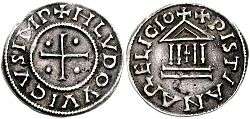
The two-rupee coin issued from 2006 by the Reserve Bank, in stark contrast to the earlier coin, is rounded and simpler in design, without the map of India. The coin has already been criticized for being difficult to recognize by the visually impaired.[6] Most controversially, it features an equal-armed cross with the beams divided into two rays and with dots between adjacent beams. According to RBI, this design represents "four heads sharing a common body" under a new "unity in diversity" theme.[7] However, Hindu nationalists have charged that the symbol is a Christian cross resembling the symbol on the deniers issued by Louis the Pious.[8]
Bimetallic Coin
India's much awaited first ever bimetallic 10 rupee coin was released in 2005 under the theme "Unity in Diversity". But, due to its controversial design resembling a cross, it was criticised and was not minted in large numbers. Another reason for its availability being scarce is that it was minted only in one (Noida) of four mints in India. Coin dealers and the public who got this coin hoarded it and it never came into circulation. It is available for sale on some auction websites, but the price of this coin is very high in comparison to its denomination due to the uncertain number of issued coins. Some coin sellers claim that this coin is a limited edition. However, official information is not yet available on the number of mintage. A press release from Reserve Bank of India mentioned that there will be two themes of 10 rupee coins: "Unity in Diversity" and "Connectivity and Information technology". From 2008 coins based on the second theme, "Connectivity and Information technology", were also released. The coin depicts 15 rays above the numeric 10. It was again minted only by the Noida mint and was not easily available in circulation. From 2011, the same theme was continued with a slight design change showing 10 rays instead of the earlier 15 and the introduction of the new Re symbol. Now it is being minted in all four mints, which are Mumbai, Kolkata, Hyderabad, and Noida. Apart from these definitive coins, 10 rupee bi-metallic commemorative coins have also been released as follows: 2008 – Tri Centenary of Gur-ta-Gaddi 2009 – Homi Bhabha Birth Centenary 2010 – RBI Platinum Jubilee 2012 – 60 Years of Parliament's first sitting.
See also
| Wikimedia Commons has media related to Coins of the Republic of India. |
References
- ↑ India - Currency, Weights and Measures, The Statesman's Year Book 1947, pg 133, Macmillan & Co.
- ↑ Schedule of Par Values, Currencies of Metropolitan Areas, The Statesman's Year Book 1947, pg xxiii, Macmillan & Co.
- ↑ India - Currency, Weights and Measures, The Statesman's Year Book 1947, pg 133, Macmillan & Co.
- ↑ Krause, Chester. Mishler, Clifford. "India-Republic," 2005 Standard Catalog of World Coins 1901-present, 32nd edition. Krause Publications. Iola, WI
- ↑
- ↑ New two-rupee coin is confusing for the blind
- ↑ RBI to come out with new Rs 2 coin
- ↑ An assault on the soul of the nation – V Sundaram